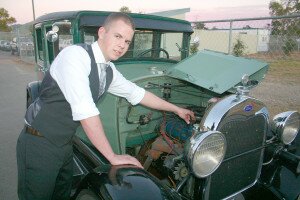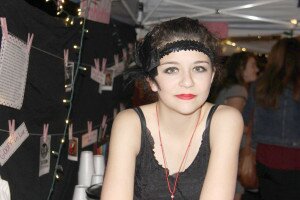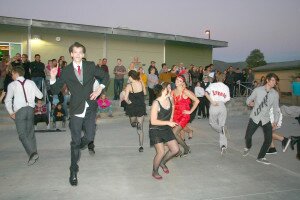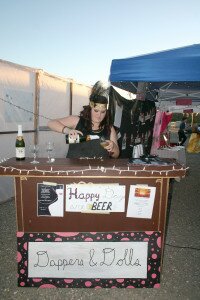Story and photos by Theresa-Marie Wilson
 In today’s world it’s a rare sight to see high school students dressed in flapper attire or slick, baggy trousers, but the joint was jumping at Central Coast New Tech High during the recent 2nd annual Party Like It’s 1929 Night.
In today’s world it’s a rare sight to see high school students dressed in flapper attire or slick, baggy trousers, but the joint was jumping at Central Coast New Tech High during the recent 2nd annual Party Like It’s 1929 Night.
The event is a signature project in which sophomores immerse themselves in 1920s culture through the creation of speakeasies, magazine production, dance performances and entertainment as well as a factory-working environment. These hands-on learning opportunities combine aspects of American history, English and digital media art.
 The decade celebrated women’s right to vote, the Jazz Age, and a burgeoning consumerism built, in part, around sales of low priced Model-T cars, newly invented electric refrigerators, and the first commercial radio station that lead to an increase in household radios. The era also saw prohibition, racial strife and an expanding divide between the wealthy and the working poor.
The decade celebrated women’s right to vote, the Jazz Age, and a burgeoning consumerism built, in part, around sales of low priced Model-T cars, newly invented electric refrigerators, and the first commercial radio station that lead to an increase in household radios. The era also saw prohibition, racial strife and an expanding divide between the wealthy and the working poor.
 “The driving question of this project, is how should we remember the 1920s,” said Jennifer Isbell, American studies and research and communication teacher. “What you are seeing is through the students’ lens of what they think we in 2015 should look back and remember, and why we should remember the 1920s—the lasting effects and how it impacts us today.”
“The driving question of this project, is how should we remember the 1920s,” said Jennifer Isbell, American studies and research and communication teacher. “What you are seeing is through the students’ lens of what they think we in 2015 should look back and remember, and why we should remember the 1920s—the lasting effects and how it impacts us today.”
 Why did New Tech choose the 1920s?
Why did New Tech choose the 1920s?
“We used that decade because it completely changed the way we feel and the way we think in our culture today in 2015,” said student Megan Garcia. “It was a big time of innovation.”
Those changes spanned advances in labor saving devices as well as cultural advancements brought about by the Harlem Renascence, a literary, artistic, and intellectual movement that led to a new black cultural identity.
Also, in 1923 the Equal Rights Amendment (ERA) was first introduced to Congress. While equality was being discussed at the Nation’s Capital, young women experienced an unprecedented freedom that included more independence, increased college attendance, and joining the workforce in large numbers.
“The flapper culture was introduced in the 1920s,” said Garcia who was dressed in appropriate fashion. “Women cut their hair short, they wore revealing dresses that showed a little more, they danced with men in fast Charleston type dances, and they began speaking out about what they wanted, what they wanted to do and their opinions. Weather or not that image was good or bad for women is debatable, but without that change in thinking, we might not be were we are today. We were finally allowed to have our political voices heard and were allowed to vote and think for ourselves.”
Students also looked at the role of labor unions, the disparity between the glamorous lives of the wealthy and the conditions of the poor, as well as business life.
“If you went to New York now, you would see businesses on Broadway and all that,” said Gerrit Vander Veen, who was playing the part of a well dressed car salesman standing in front of a Model A Ford. “Back then, Wall Street, all of it, was car dealerships because they were the biggest thing in the business. These were the workingman’s cars. They were one of the greatest selling cars of all time.”
Stepping into the 1920s outside of the more traditional classroom experience gave students deeper understanding.
“There is definitely a personal attachment to it,” said Garcia. “If you are reading about it in a text book, you are like, ‘Yep, those are facts.’ When you act it out and you have to collaborate with other people and really immerse yourself in the culture of it, it is much more lasting.”
As part of the program, students also produced magazines representing the lifestyle of the era. They were required to write a feature article and a letter to the editor from the persona of a character from the Great Gatsby as well as create an advertising element. Students learned to use Adobe InDesign to create the magazines.
The New Technology educational system is built around project-based learning where students collaborate to create a multi-faceted solution or experience through integrated subject matters with technology as a unifying tool.
Upon graduation, students attending the school will have completed college courses, given more than 200 multimedia presentations, completed internships, performed community service, worked on real-world projects and have a digital resume portfolio. The education plan is designed to encompass the basics while also ushering in the district’s seven 21st Century Learning Skills while meeting the California state standards.




